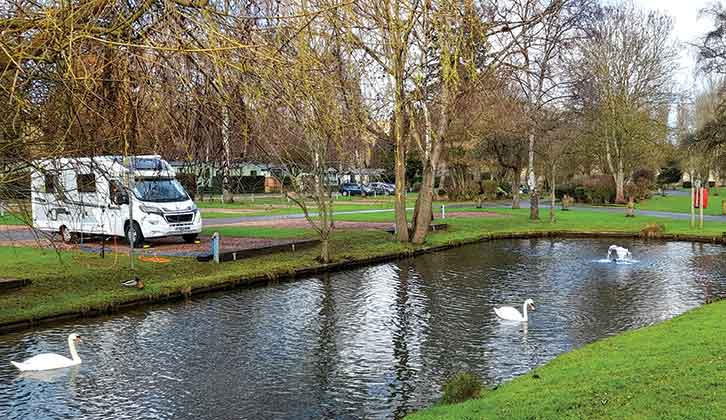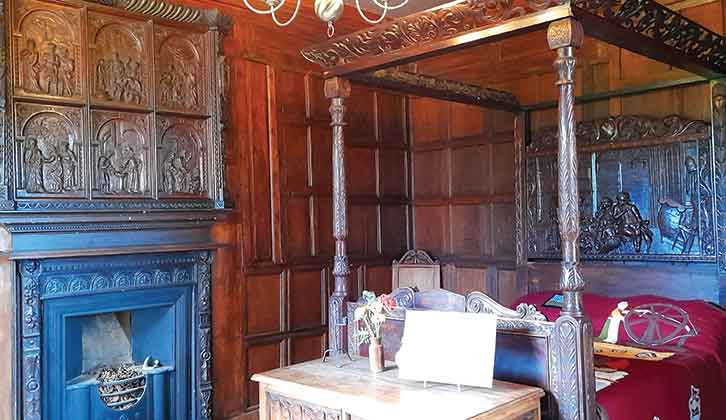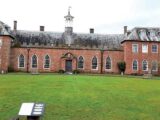Officially, the winter was over, and crocuses and daffodils heralded the start of spring, so we were really feeling the need to get away for a long weekend.
However, the weather was still being decidedly fickle, so we opted to head somewhere scenic, but with a choice of interesting places where we could escape indoors if necessary.
We based ourselves at Lickhill Manor Caravan Park, Stourport, Worcestershire. The motorhome site is beautifully landscaped with mature trees, bushes and peaceful ponds.
Arriving on site in the early afternoon, we set up quickly and because the weather was fine, decided to take a walk into Stourport, to get our bearings and pick up some essentials.

The Severn Way
A riverside path, which is part of the Severn Way long-distance footpath, runs from the campsite into Stourport. It’s just under a mile and is a manageable stroll beside the river, although as you would expect, it can sometimes be muddy.
There is an alternative route, which takes you through a housing estate behind the site and onto the road. This is much the same distance and less muddy – but not as pretty.
Stourport was originally a small village, until the Staffordshire and Worcestershire Canal was built in 1771. Connecting the Severn to the newly built Trent and Mersey Canal, this linked four rivers – the Severn, Mersey, Trent and Thames.
As a result, Stourport became a thriving town and transport hub. By 1812, five canal basins had been constructed and it had become the busiest inland port serving the Midlands.
Today, the scenic river and waterways bring in scores of tourists during the summer months. The river runs along the southern edge of the town and the canals connect with the river at the historic canal basin site. This is a fascinating area of locks with narrow and wide canals.
The weather was not kind on the March afternoon we visited and everything was looking a little forlorn and damp, but even so, you could immediately see that the canal basin is part of the special magic of this town (and check out our guide to sites for canal and river walks if you enjoy a walk by the water).
As we walked, we appreciated the fine Georgian buildings around the canal and decided a visit on a sunny day would be worthwhile.
Next morning, we woke to the sound of rain, but it eased before we ventured out. Having breakfast in the ’van, we watched ducks and swans going about their day, and a buzzard, who had been out hunting, enjoying his breakfast, too!
Worcester Cathedral
We decided to visit Worcester and after enduring a long drive in dreadful weather the day before, opted for public transport. There are bus stops on the road outside the caravan park, and there is a direct bus to Worcester, although checking the timetable online is essential – the services are not particularly frequent.
They do, however, take you right into the city centre, which is very convenient. By the time we got to Worcester, the heavy rain had settled down to a gentle drizzle, so we went straight to the cathedral as our first stop.
This ancient building stands on the site of an earlier church that dates back to 680. The cathedral, attributed to Saint Wulfstan, was established in 1084 as a Benedictine monastic house and church. It became an important centre of learning and some of the great medieval texts are still housed in the Cathedral Library.
Henry VIII dissolved the monastery in 1540, but the cathedral continued to thrive until it suffered major damage during the years of the Civil War, requiring considerable repair and rebuilding in the reign of Charles II.
It is a magnificent building and free to enter, although a voluntary donation is requested.
One of the key features is the tomb of King John, of Magna Carta fame. He has generally been portrayed as a tyrant, but historians now recognise this might not be entirely accurate
and could simply reflect the biased reporting of those times.
Tyrant or not, John was very keen to be buried at Worcester and his splendid tomb and monument have a prominent place in the opulent Quire of the cathedral. There are numerous rather imposing tombs to view here, of great knights and other prominent local people.
The fine Chapter House is still used as a meeting room, and we were pleased to see some weak rays of sunshine attempting to make an appearance as we wandered around.
The Cloister is beautiful, and encloses the peaceful Garth Garden. It also houses a pleasant tearoom, where we enjoyed a drink and a snack before heading outside again.
The Commandery
We left the cathedral, pleased to find that the rain had stopped, and walked the short distance to see The Commandery. This historic building, now housing a museum, is close to the city centre, but when it was first established, it was near one of the ancient city gates, Sidbury Gate.

It is most famous for its role as the Royalist command centre during the last battle of the Civil War, although the building pre-dates this.
In fact, the name actually pre-dates the Civil War, too, and there is a theory that it was built for the Knights Templar or Knights Hospitaller, although there is no proof of this. Their fortified bases were usually called Commanderies, so that could explain the name, however.
What is known is that this fine building fulfilled an important role as a medieval hospital, offering accommodation and support to the many people travelling around the area, and eventually serving as much more of a medical hospital, as we would understand the term today.
The house later became the home of a wealthy local merchant and his family. It is a sprawling building, over two floors, and these days, the main exhibition area has interactive displays telling the story of the last battle of the Civil War and some of the people involved.

The house was the home of the Wylde family in Tudor times and a number of the rooms have been beautifully dressed to represent this period. The fine panelled bedroom shows that these were wealthy and influential people.
The Wyldes still owned the property at the outbreak of the Civil War and as supporters of the king, allowed the house to be used as the Royalist campaign headquarters.
It is close to the site of Fort Royal, which had been built to defend the surrounding area, so was probably the ideal location.
After the end of the Civil War, The Commandery continued as a family home, and displays show how the building was adapted as a Georgian townhouse in later years.
There is actually far more to see here than we had expected, so we didn’t have time to stop at the café overlooking the canal, but this would make a pleasant way to finish your visit.
Tudor House Museum
After leaving The Commandery, we decided to head back to the city centre. This is a pleasantly scenic stroll, and there are plenty of well-placed signposts to help visitors find their way around.
Walking down Friar Street, one of the oldest streets in Worcester, we paused to admire the beautiful half-timbered houses and interesting shopfronts. The street gets its name from the ancient Greyfriars friary, an important religious institution for a Franciscan order that once stood just outside the city walls.
Here we came across the Tudor House, a quirky timber-framed building housing the small but fascinating museum managed by the Worcester Heritage and Amenity Trust. The enthusiastic volunteers greet visitors and have a wealth of information to offer. It is also free to enter.

This historically important property was built some time between 1485 and 1555, and would originally have been three separate dwellings, with weaving sheds to the rear. The weavers who lived there would have made broadcloth, a local fabric known for its exceptionally high quality and widely exported.
The museum has interesting displays describing the weaving processes and the history of the Clothiers Guild, one of the many medieval trade guilds of great importance to the city.
Then they introduce Edward Cottryl, a weaver known to have lived in the property, and his family, and you can visit the upstairs room, showing how it might have looked in those days.
The building had many uses over the years. In 1654, William Welfare opened a tavern here. It seems he was having trouble making a living weaving broadcloth, so he decided an inn might be a better business proposition!
The tavern continued to trade until some time around 1907, when it became a coffee shop. There is some entertaining information about just a few of the many customers and landlords featuring in its long and lively history.
This is not a museum of Tudor times, but rather a museum of the house itself, which seems to date from that period. It was an excellent find and well worth a visit. It also has a small tea shop if you need to take a break after exploring.
Sadly, as we left the museum, the weather had decided to close in again, so we made our way to the bus station to catch our bus back to the campsite.
Our visit to this splendid city was all too brief: there is plenty to see and enjoy here, and one day is not enough to do the place justice.
Hartlebury Castle
Saturday morning dawned overcast but dry, so we drove the short distance to Hartlebury Castle, just outside Stourbridge. There, we had no problems with parking, particularly on a quiet morning in March.
Hartlebury Castle is pretty much unique and is definitely not your normal, run of the mill stately home.
The earliest house on the site was thought to have been built in 855, then over the years, it was extended and fortified many times, until by 1268, it had been officially designated a castle.

Hartlebury was the official residence of the Bishops of Worcester for hundreds of years (until 2007, in fact), so in addition to being a fine manor house, and then a castle, it was also a palace!
During the Civil War years, it was held for the Royalist supporters by one Captain William Sandys, although he surrendered after two days, without a shot being fired.
Unfortunately, this move did not prevent the opposing forces from destroying the fortifications – and they were never rebuilt.
In 1782, a library was established by Bishop Richard Hurd, to house his fine collection of books. The Hurd Library still exists today and is home to many rare and precious volumes.

As you might expect from such a long history, the palace and the bishops who lived there were involved in a fair amount of intrigue – political and ecclesiastical – over the years, and there are numerous important and fascinating links with the history of England itself.
Hartlebury Castle has also hosted many royal visitors, Edward I in 1282 being the first, followed by Elizabeth I in 1575 and many others over the years, right up until the present day.
During World War I, the building served as a Voluntary Aid Detachment hospital and there are some fascinating oral history accounts and displays about this period.
Keeping up with contemporary developments, the house is well equipped with multimedia displays, including talking pictures, which children would love, and informative personal audio guides are also available.
The history of the building is fascinating, and the stories of the people involved really bring it to life. One wing now houses the Worcestershire County Museum and entrance to this is included in the general admission price.
This small, very interesting museum features a wonderful Victorian schoolroom. The Travel and Transport Gallery also looked rather inviting, although it was shut on the day we visited.
We didn’t have time to explore the grounds, but they also look very attractive. There is a trail here, the Perimeter Walk, set in beautiful countryside, which would be lovely on a sunny day.
Sadly for us, the rain was back yet again, so we decided to head for shelter in the café, where we enjoyed a late lunch.
Harvington Hall
On the final day of our break, we decided to visit Harvington Hall, where we had booked a guided tour in advance. Volunteer guides take groups of visitors around this splendid house, and I would highly recommend taking the tour, because it would be easy to miss some of the fascinating details the guides point out, and the stories that really bring the place to life.
Harvington Hall is a grand Elizabethan moated manor house, constructed on the site of a previous dwelling, a smaller timber-framed building on an artificial island. Our friendly guide told us there were carp in the moat – and claimed that he knew each of them by name!
The fine manor house that you see today was significantly extended, after being inherited in 1578 by Humphrey Pakington, a Catholic. In order to continue to practise his faith in those turbulent times, he took the opportunity to have several priest holes built throughout the house. In fact, it contains seven such hiding places, apparently the most of any great house in England.
The house retains many of its beautiful original features, and some of the floors are uneven, and the stairs narrow and often winding. Almost every room has a step as you enter.
Although obviously not easily accessible, this is authentic and as you make your way around the interior, the historic atmosphere of the building simply envelops you.
When you have finished exploring, you’ll find there is an excellent café offering light snacks and drinks. There is also ample parking, too, but be aware that your sat nav may try to take you down some very narrow roads to get there.
We ignored the sat nav and stayed on the main A450, turning off at the brown sign on to Park Lane. It was marked as a narrow road with no passing places, but it was only narrow for a short distance and then there are passing places, so it’s actually a reasonable option.
Next morning, reluctantly, we were heading for home. The weather hadn’t been very kind to us over our weekend, but we were still able to see some lovely places. It made a great break while waiting for the better weather!
Take a look at our best campsite guide if you’re after some inspiration for where to go camping too.
When to go on a tour to Worcestershire
This beautiful part of the world has much to offer visitors at any time of the year. We went in the early spring, so the weather was a bit unreliable, but there is plenty to enjoy indoors when you’re dodging the rain.
Where we stayed in Worcestershire
Lickhill Manor Caravan Park
Stourport-on-Severn, Worcestershire DY13 8RL, hillandale.co.uk/our-parks/lickhill-manor-caravan-park
- Open: All year
- Pitches: 300
- Charges: From £32
This 62-acre site is conveniently close to Stourport. It is beautifully landscaped, with ponds, trees and shrubs. There are several zones, with a mix of hardstanding and
grass pitches, ranging from fully serviced super-pitches to simple grass spots with no facilities. The site is also home to a large number of lodges and statics, all very well maintained.
Find out more about the attractions we saw in Worcestershire
Lead image: Getty
Looking for some more touring inspiration? Then check out these trips and guides:
- We round up the best motorhome sites in Norfolk.
- Nick Harding and his partner Lin follow Route YC.
- A tour to Croatia and Slovenia allowed Elaine and Joe Ormerod to take in some stunning architecture.
If you’ve enjoyed reading this article, why not get the latest news, reviews and features delivered direct to your door or inbox every month. Take advantage of our brilliant Practical Motorhome magazine SUBSCRIBERS’ OFFER and SIGN UP TO OUR NEWSLETTER for regular weekly updates on all things motorhome related.







